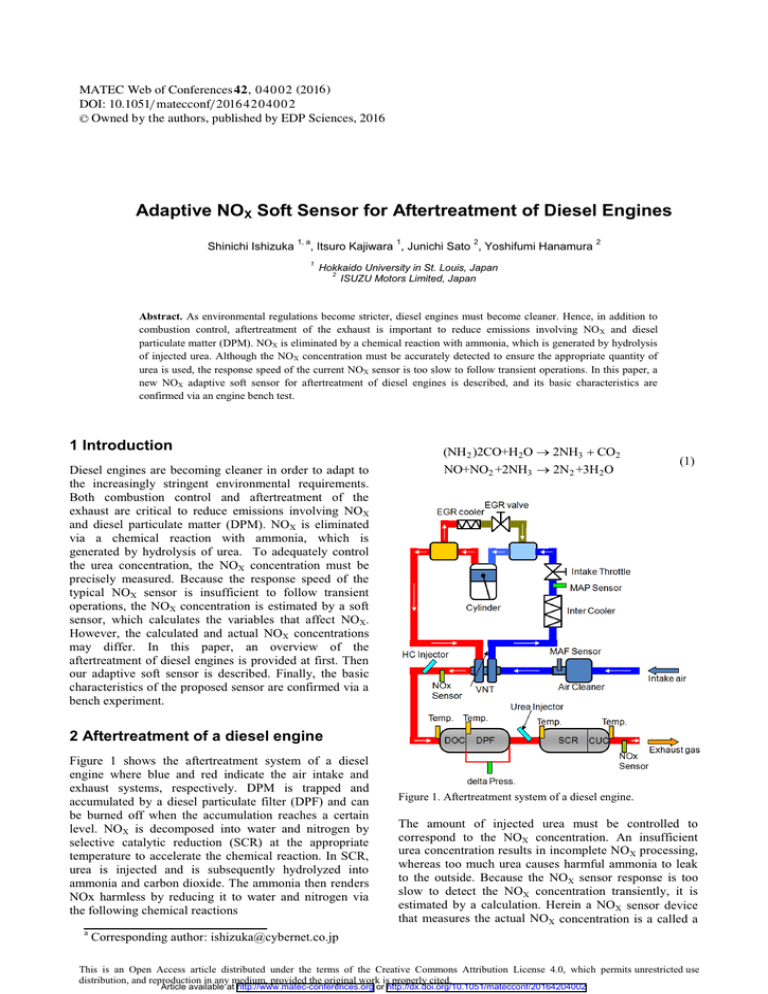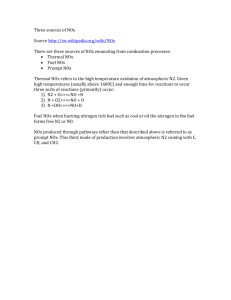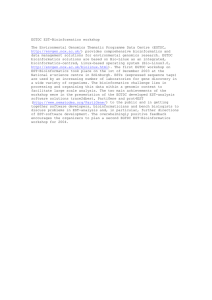Adaptive NO Soft Sensor for Aftertreatment of Diesel Engines
advertisement

MATEC Web of Conferences 4 2 , 0 4 0 0 2 (2016 ) DOI: 10.1051/ m atecconf/ 2016 4 2 0 4 0 0 2 C Owned by the authors, published by EDP Sciences, 2016 Adaptive NOX Soft Sensor for Aftertreatment of Diesel Engines Shinichi Ishizuka 1, a 1 2 , Itsuro Kajiwara , Junichi Sato , Yoshifumi Hanamura 1 2 Hokkaido University in St. Louis, Japan 2 ISUZU Motors Limited, Japan Abstract. As environmental regulations become stricter, diesel engines must become cleaner. Hence, in addition to combustion control, aftertreatment of the exhaust is important to reduce emissions involving NO X and diesel particulate matter (DPM). NOX is eliminated by a chemical reaction with ammonia, which is generated by hydrolysis of injected urea. Although the NOX concentration must be accurately detected to ensure the appropriate quantity of urea is used, the response speed of the current NOX sensor is too slow to follow transient operations. In this paper, a new NOX adaptive soft sensor for aftertreatment of diesel engines is described, and its basic characteristics are confirmed via an engine bench test. 1 Introduction Diesel engines are becoming cleaner in order to adapt to the increasingly stringent environmental requirements. Both combustion control and aftertreatment of the exhaust are critical to reduce emissions involving NOX and diesel particulate matter (DPM). NOX is eliminated via a chemical reaction with ammonia, which is generated by hydrolysis of urea. To adequately control the urea concentration, the NOX concentration must be precisely measured. Because the response speed of the typical NOX sensor is insufficient to follow transient operations, the NOX concentration is estimated by a soft sensor, which calculates the variables that affect NOX. However, the calculated and actual NOX concentrations may differ. In this paper, an overview of the aftertreatment of diesel engines is provided at first. Then our adaptive soft sensor is described. Finally, the basic characteristics of the proposed sensor are confirmed via a bench experiment. (NH2 )2CO+H2O 2NH3 CO2 NO+NO2 +2NH3 2N2 +3H 2O (1) 2 Aftertreatment of a diesel engine Figure 1 shows the aftertreatment system of a diesel engine where blue and red indicate the air intake and exhaust systems, respectively. DPM is trapped and accumulated by a diesel particulate filter (DPF) and can be burned off when the accumulation reaches a certain level. NOX is decomposed into water and nitrogen by selective catalytic reduction (SCR) at the appropriate temperature to accelerate the chemical reaction. In SCR, urea is injected and is subsequently hydrolyzed into ammonia and carbon dioxide. The ammonia then renders NOx harmless by reducing it to water and nitrogen via the following chemical reactions a Figure 1. Aftertreatment system of a diesel engine. The amount of injected urea must be controlled to correspond to the NOX concentration. An insufficient urea concentration results in incomplete NO X processing, whereas too much urea causes harmful ammonia to leak to the outside. Because the NOX sensor response is too slow to detect the NOX concentration transiently, it is estimated by a calculation. Herein a NOX sensor device that measures the actual NOX concentration is a called a Corresponding author: ishizuka@cybernet.co.jp This is an Open Access article distributed under the terms of the Creative Commons Attribution License 4.0, which permits XQUHVWULFWHGXVH distribution, and reproduction in any medium, provided the original work is properly cited. Article available at http://www.matec-conferences.org or http://dx.doi.org/10.1051/matecconf/20164204002 MATEC Web of Conferences "NOX hard sensor", while a sensor that calculates the NOX concentration from other factors is called a "NO X soft sensor". In the conventional method, a NOX hard sensor is used during stationary operations, but it is switched to a NOX soft sensor during transient operations. In this paper, an adaptive NO X soft sensor method, which is compensated by a NOX hard sensor, is proposed. O2: SOI: RP: Tcool: Tinm: O2 concentration Main injection timing Rail pressure Temperature of the cooling water Temperature of the intake manifold Each term is described as αO 2 ψO 2, cyl CO 2 ψO 2, cyl , ref αSOI θSOI θSOI ,ref CSOI e CRP αRP prail prail , ref 1 CTcool αTcool Tcool Tcool , ref 1 αTinm Tinm C Tinm Tinm, ref 3 NOX soft sensor 3.1 Basic composition A typical soft sensor employs either a just-in-time model [1] or a neural network-based [2] method. However, these methods are not model based and the factors that influence NOX are indistinct. From the viewpoint of practical calibrations, a soft sensor should be structured so that the effect of each factor can be tuned independently and simultaneously. In this study, an experiment-based soft sensor model is used. Figure 2 shows the NOX soft sensor scheme where the dashed red and solid blue lines denote parameters and variables, respectively. The NOX soft sensor calculates the NOX concentration as shown in Equation 2: ψNOx ψNOx, ref CO 2 CSOI CRP CTcool CTinm (2) where ψ NOx is the NOX concentration as a mole fraction. The terms on the right-hand side affect NOX, and the subscripts denote (3) In Equations (1) and (2), the variables with subscript the ref denote the nominal values under normal atmospheric conditions, while the variables with a* indicate calibration factors when the operation condition differs from the standard condition (i.e., the variable does not affect the calculated value when the state is the same as the normal condition). Each nominal value (,ref) and calibration factor (a*) can be plotted to form a 2D map using engine speed and fuel injection quantity as the parameters. Figure 2. Scheme of the NOX soft sensor. Figure 3. Composition of the adaptive NOX soft sensor. 04002-p.2 ICCMA 2015 3.2 Adaptive NOX soft sensor To eliminate the offset in a NOX soft sensor, the gain of the offset is compensated compared with the NOX hard sensor value. Figure 3 diagrams the proposed adaptive NOX soft sensor. SPSA stands for the simultaneous perturbation stochastic approximation, which was originally proposed by Spall in 1987 [3] as a very efficient optimization technique. An online adaptive tuning method using a modified SPSA is proposed by the authors [4], [5]. In this study, our modified SPSA is utilized. The NOX soft sensor value NOxsoft is derived from predictor Gpredict, which predicts the behavior of the NOX hard sensor dynamics. Gpredict is calculated from loss function L and modified gain kcomp. Each term C* is tuned simultaneously and continuously by the modified SPSA. medium truck with a displacement of about 5,200 cc. Table 1 shows the specifications, and Figure 4 shows the engine bench. In Equqtion (3), the nominal variables with the ref subscript and calibration variables a* are tuned for the experimental engine. Generally, an engine’s characteristics change during operation and due to aging. To reproduce these situations, each calibration map changes 1.5 times (i.e., the calibration map contains some errors and the operation conditions are altered as shown in Table 2). Table 1. Engine specifications. 3.3 SPSA algorithm The modified SPSA is briefly described here. For more details, refer to [4]. The estimated value of the loss function gradient is expressed as θˆk 1 θˆk ak ĝ k θˆk Type Direct injection, DOHC, IC turbo Displacement 5193 cc Compression ratio 15.5 Maximum power 140 kW / 2600 rpm Maximum torque 510 Nm / 1600 rpm Regulation Euro 6 (4) where is the estimated optimization parameter vector, ak is the update gain, and g k ( ) is the estimated value of the gradient for the parameter, which is described as ĝk ˆk L ˆk ck ck k 1 kk1 1 1 k2 (5) 1 kp kp where L is the loss function, ck is a coefficient with a minute positive value to adjust the perturbation, and △k is a bounded p-dimensional random number vector with a symmetric distribution when the expected value is 0 and no element can ever be zero (e.g., a Bernoulli distribution). For example, Equation (6) shows a random number vector expressed as a random binary sequence k 11, 1, 1, 1, 1, 1, 1, T Figure 4. Engine bench. Table 2. Operation conditions (6) By choosing ak and ck appropriately and iterating Equation (4) recursively, the estimated optimal parameters converge to an optimal value as a stationary system. The standard SPSA evaluates the loss function twice by perturbing all the tuning parameters simultaneously. In this case, a one-time evaluation SPSA [6] is used. The sum of the squared error is used as the loss function. 4 Experiment 4.1 Engine bench The adaptive NOX soft sensor algorithm was modeled with Simulink and downloaded to a rapid controller prototyping environment. The diesel engine was for a Changing item Notes EGR valve Half of the nominal amount Injection timing 2 degree retard of the crank angle Rail pressure -30 MPa 4.2 Test pattern The test was carried out at the middle and high engine speed points while changing the amount of fuel injection such that the load was changed stepwise. The upper plot in Figure 5 shows the test pattern. The blue and green lines indicate the engine speed trace and the change in the amount of fuel injection, respectively. The lower plot in Figure 5 shows the NOX concentration where black, green, blue, and red lines indicate the values measured by a hard sensor, a soft sensor without 04002-p.3 MATEC Web of Conferences significantly from the hard sensor. Although the error is slightly smaller in the case of the soft sensor without calibration map error, the error is still large. However, the proposed adaptive soft sensor can adapt to appropriately reduce the error. 䣑䣲䣧䣴䣣䣶䣫䣱䣰䢢䣥䣱䣰䣦䣫䣶䣱䣰 䢵䢲䢲䢲 䢳䢲䢲 䢴䢲䢲䢲 䢳䢲䢲䢲 䢲 䢴䢲䢲 䢶䢲䢲 䢸䢲䢲 䣊䣣䣴䣦䢢䣵䣧䣰䣵䣱䣴 䣕䣱䣨䣶䢢䣵䣧䣰䣵䣱䣴䢢䣹䣱䢢䣏䣃䣒䢢䣧䣴䣴䣱䣴 䣕䣱䣨䣶䢢䣵䣧䣰䣵䣱䣴䢢䣹䣫䣶䣪䢢䣏䣃䣒䢢䣧䣴䣴䣱䣴 䣕䣒䣕䣃䢢䣃䣦䣣䣲䣶䢢䣕䣱䣨䣶䢢䣵䣧䣰䣵䣱䣴 䢴䢷䢲 䢲 䢳䢲䢲䢲 䣐䣑䣺䢢䣖䣧䣵䣶 䢵䢲䢲 䣅䣱䣰䣥䣧䣰䣶䣴䣣䣶䣫䣱䣰䢢䣱䣨䢢䣐䣑䣺䢢䢪䣲䣲䣯䢫 䢺䢲䢲 䣳䣨䣰䣮䢢䢪䣯䣯䢵 䢱䣥䣻䣮䢫 䣇䣰䣩䣫䣰䣧䢢䣵䣲䣧䣧䣦䢢䢪䣴䣲䣯䢫 calibration map error, a soft sensor with calibration map error, and an adaptive soft sensor with calibration map error. To make a direct comparison of the hard and soft sensors, the dynamics of each soft sensor response is compensated by the hard sensor delay. In the case of the soft sensor with calibration map error, the value deviates 䢢 䢴䢲䢲 䢳䢷䢲 䢳䢲䢲 䢷䢲 䢲 䢯䢷䢲 䢢 䢲 䢴䢲䢲 䢶䢲䢲 䢸䢲䢲 䣖䣫䣯䣧䢢䢪䣵䢫 䢺䢲䢲 䢳䢲䢲䢲 Figure 5. NOX test results. 5 Summary References This study investigates the use of NOX soft sensors in the aftertreatment of diesel engines. To eliminate the offset from the NOX hard sensor, an adaptive NOX soft sensor using SPSA is proposed. The most distinctive feature of the SPSA algorithm is that the calculation only requires that the loss function be determined once or twice per iteration regardless of the number of optimization parameters. In this study, the soft sensor model has five calibration terms, which are simultaneously updated and tuned using SPSA. The adaptability of the proposed method is confirmed using a stepwise engine bench test. Even if the condition differs significantly from the standard condition, the proposed method adapts appropriately. In the future, it is planned to investigate the proposed method under transient conditions like a world harmonized transient cycle (WHTC). 1. 2. 3. 4. 04002-p.4 A. Saptoro, State of the Art in the Development of Adaptive Soft Sensors based on Just-In-Time Models, Procedia Chemistry, Vol. 9, pp. 226-234 (2014). M. Shakil, M. Elshafei, M. A. Habib and F. A. Maleki, Soft sonsor for NOX and O2 using dynamic neural networks, Computers and Electrical Engineering, Vol. 35, pp. 578-586 (2009). J. C. Spall, A STOCHASTIC APPROXIMATION TECHNIQUE FOR GENERATING MAXIMUM LIKELIHOOD PARAMETER ESTIMATTES, Proceedings of the American Control Conference, Minneapolis, MN, pp. 1161-1167 (1987). S. Ishizuka and I. Kajiwara, Online adaptive PID control for MIMO systems using simultaneous perturbation stochastic approximation, JSME Journal of Advanced Mechanical Design, Systems, and Manufacturing, Vol. 9, No. 2 (2015). ICCMA 2015 5. 6. S. Ishizuka, I. Kajiwara, J. Sato, Y. Hanamura and S. Hanawa, Model-free adaptive control scheme for EGR/VNT control of a diesel engine using the simultaneous perturbation stochastic approximation, SAGE Transactions of the Institute of Measurement and Control, Online fist published on Sept. 4 (2015), http://tim.sagepub.com/content/early/2015/08/28/014 2331215602327.abstract J. C. Spall, A One-measurement Form of Simultaneous Perturbation Stochastic Approximation, Automatica, Vol. 33, No. 1, pp. 109-112 (1997). 04002-p.5



